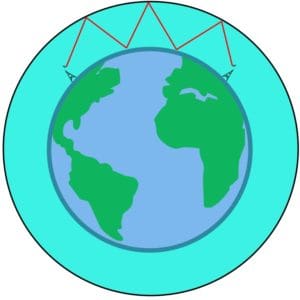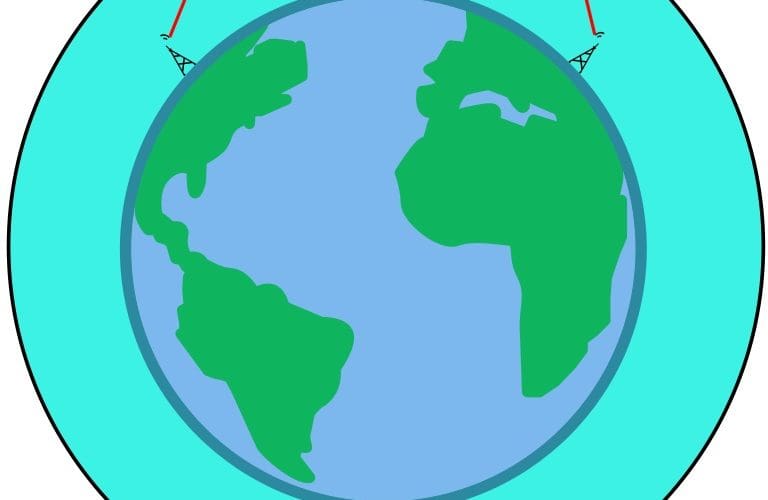
Even though satellite communications is taking an ever bigger slice of the voyaging communications pie, high frequency (HF) marine SSB is still used by voyagers. Here is a rundown of the basics of HF radio signal propagation to aid in using it effectively.
HF radio energy traveling through the atmosphere or through space is subject to very little attenuation and the energy would arrive at the receiver as strong as it was radiated. Not all radio frequencies behave in the same way, however. Extremely high frequencies, higher than 10,000 MHz, can be attenuated by moisture and dust particles in the air.
While the atmosphere has its effect on radio energy, the surface of the Earth also has an effect. The Earth acts like a big sponge, absorbing radio energy that comes into contact with it. This surface attenuation is proportional to the frequency involved: low for lower frequencies and much greater for higher frequencies. Even though salt water has the lowest surface attenuation, frequencies much greater than roughly three megahertz will seldom give surface coverage for distances greater than 150 to 200 miles.
Both atmospheric (primarily lightning) and man-made noise can combine to mask radio communications. This type of noise is greater at the lower frequencies and rapidly diminishes in strength at higher frequencies. During a summer evening in the tropics, for example, lightning noise can be devastating to communications at frequencies below 10 MHz.
In the earliest days of radio it was thought that energy radiated upward from the antenna would travel off into space and be wasted, but it was discovered that some frequencies can be reflected back to Earth by a region called the ionosphere, making reception over thousands of miles possible. Understanding how this sky wave phenomena works helps us anticipate what frequency to use for communication when we’re far at sea.
It might be helpful to explain the term frequency, It simply means the number of times per second that the transmitter causes the current in the antenna to change direction. For example, the current in a home wall plug alternates back and forth 60 times each second, or at a frequency of 60 hertz (one hertz equals one cycle per second in modern radio jargon). The HF band is defined as those signals that change direction between 3,000,000 and 30,000,000 times a second or three to 30 MHz. A receiver selects one transmitter from all others by responding only to the frequency broadcast by that transmitter.
Before the effects of the ionosphere were known, it was thought that all frequencies above about 1.5 MHZ would be useless because of the Earth’s attenuation of the higher frequencies. All frequencies “200 meters and down” (in those days wavelength was the common measure of frequency) were relegated to use by amateur operators. That didn’t last long, however. As soon as amateurs discovered that the ionosphere made communications possible over thousands of miles, government and commercial services were quick to take back most of frequencies that had been allocated to amateurs.
The ionosphere allows long-distance communications to take place because of its physical structure. It is a series of layers of atmospheric particles charged by the sun’s radiation, about 60 and 200 miles above the Earth. The reflection process depends on the intensity of the region’s charge and the frequency of the radio wave. The more intensely the ionosphere is charged, the higher the frequency of the radio wave that will be reflected. Signals above the highest reflected frequency, called the maximum usable frequency (MUF), pass through the ionosphere and on out into space. Since the MUF depends upon the intensity of solar radiation, it follows that it varies with time of day, time of year and the variations in solar activity, or the sunspot cycle. It is seldom much above about 30 MHz. This explains why marine VHF (about 156 MHz) and broadcast TV (spread around between 56 MHz and 800 MHz) are basically line-of-sight systems. Energy at these frequencies that goes up from he antenna just keeps going out into space.
The higher a radio wave’s frequency, the deeper into the ionosphere it penetrates and therefore, if it is reflected back at all, the farther from the transmitting antenna it will return to Earth. That is why we want to use the highest frequency possible (the MUF) whenever we want long-distance contacts.
The more intensely the ionosphere has been charged by the sun, the nearer to the Earth the wave will be reflected. Therefore, it returns closer to the transmitter. So, the state of charge affects the range of our signals.
Radio energy doesn’t travel in a thin, pencil-like line. More like our expanding balloon, it’s in a broad beam that strikes the ionosphere over a wide area and returns to Earth over an even wider region. The catch here is that when the ionosphere is highly “pumped up” the higher frequencies that otherwise would pass on through are reflected back from the highest regions, thereby returning to the surface farthest from the transmitter. This means that those high frequencies that are most attenuated by the surface of the Earth, and therefore have the shortest ground wave propagation, can provide the longest-distance sky wave propagation, if conditions are right.
Since it is the sun that charges the ionosphere, it follows that the intensity of the charge depends both on the time of day and the time of year. At night the charge dissipates until the next day when the sun’s energy pumps it back up again. When the Earth is closest to the sun (during the Northern Hemisphere’s winter), the Sun’s more intense radiation intensifies the ionosphere’s ability to reflect radio energy.
The extent of the ionosphere’s charge also depends on sunspot activity. Sunspots are solar eruptions that have a great influence on the sun’s ionizing effects. Sunspot activity follows an 11-year cycle, so the pattern of radio propagation follows a similar, 11-year cycle.
These theoretical concepts permit us to make some useful generalities about propagation at different times and frequencies. But just as weather forecasters can predict the seasons pretty well and still be right only about 75% of the time in telling us if it will rain or not, so with radio propagation forecasts. General prognostications are pretty good, but mother nature can always throw in a surprise or two.

